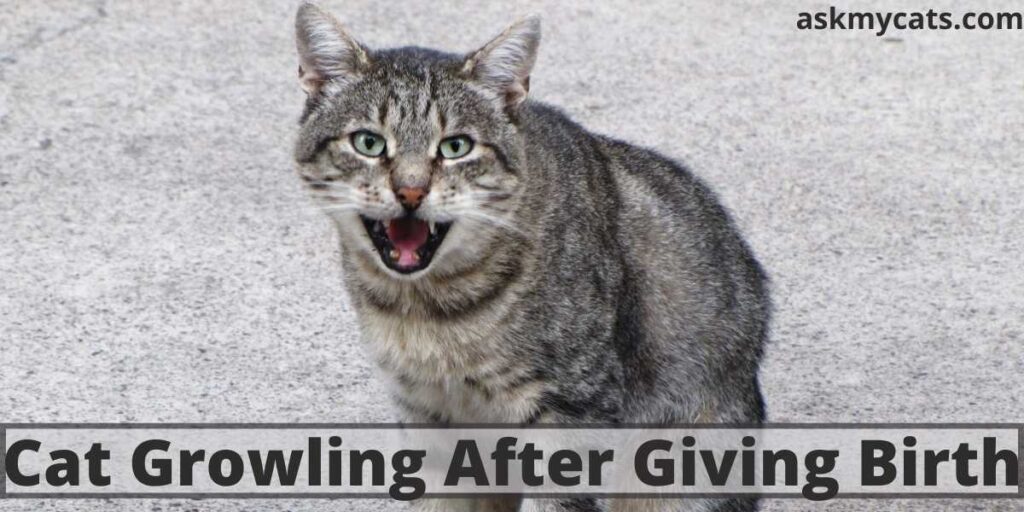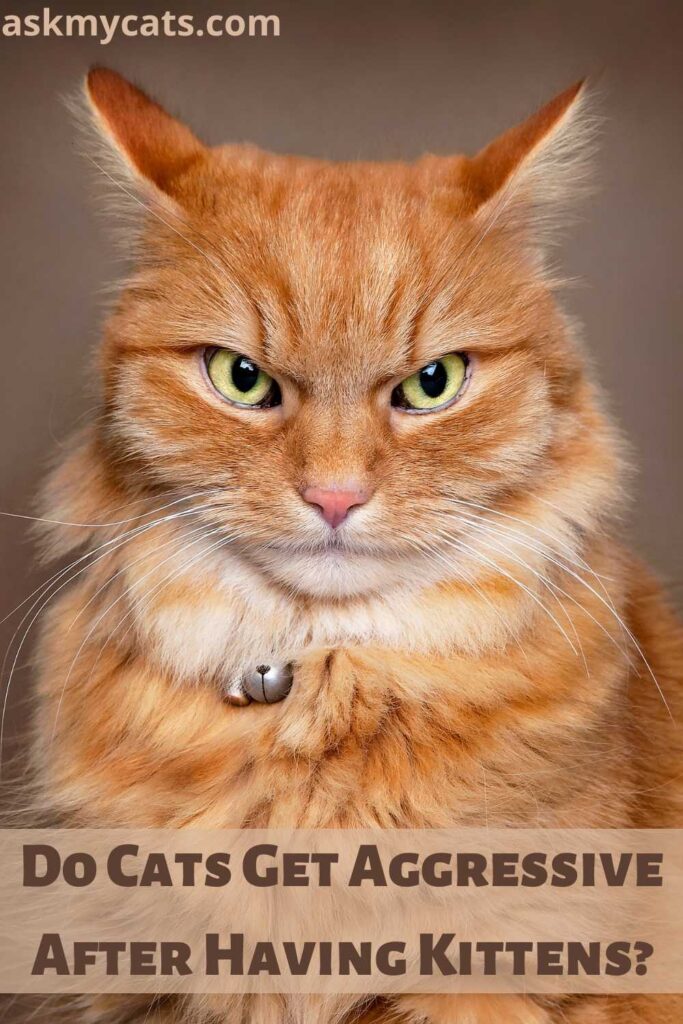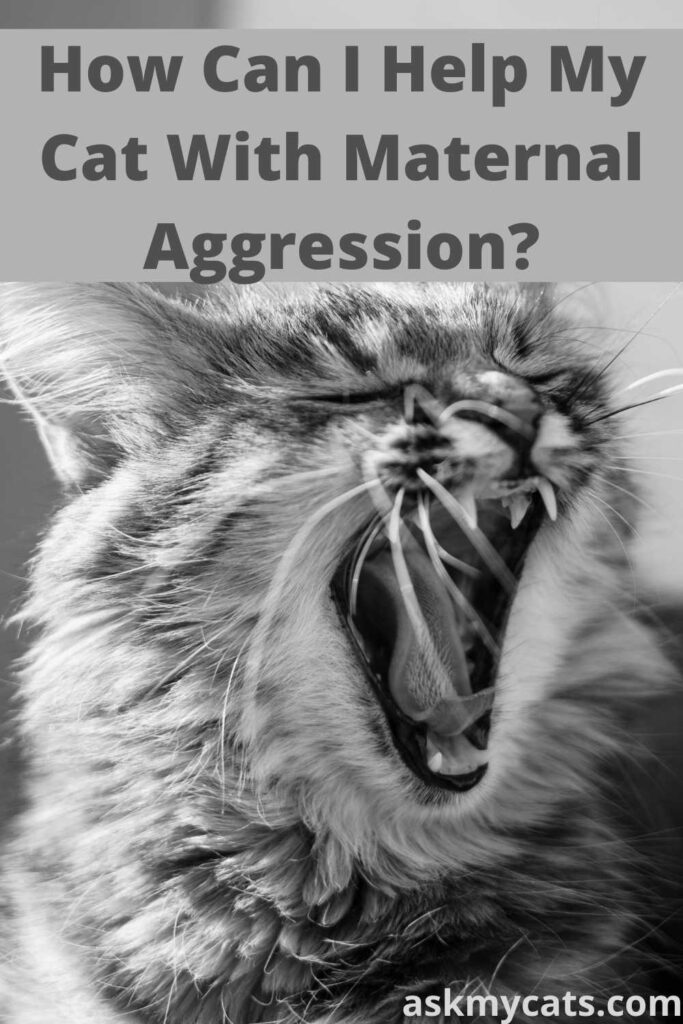When our cat has a litter of kittens, it’s an exciting moment for us humans. For the mother cat, this particular time is equally frightening and nerve-wracking. Her instincts tell her that she must protect her litter at all costs, which can make her acts seem odd.
So, why is your cat growling after giving birth?
There could be many reasons why your cat is growling after giving birth, but the most prominent one is that she is trying to protect her kittens.
Keep reading this article to know about the reasons behind your cat growling after giving birth.


Give Your Cat the Perfect Day
Get the Free Ebook!
Do Cats Get Aggressive After Having Kittens?
Yes, cats can get aggressive after having kittens.

When a cat becomes a mother, even the sweetest, most friendly feline can transform into a hissing, growling lunatic.
Momma cats are their newborn kittens’ only source of security, and they will go to great lengths to keep them safe.
Even the loveliest pet cat has trouble comprehending that her people do not want to kill her kittens.
Most mothers, especially first-time mothers, will lash out at anyone who gets too close to their kittens.
Although the behavior may appear weird for your loving kitty companion, it is very normal and will fade as the kittens grow older.
They may have been best friends since birth, playing and sharing every moment, but once one cat becomes a mother, she usually refuses to interact with any other cats.
Even if the other cat is nowhere near her kittens, she may chase him away. This is because male cats frequently kill kittens, and the mother cat wants to ensure that her offspring are completely safe.
Her tolerance of other cats, like her tolerance of human aggressiveness, will return as the kittens get larger and are able to fend for themselves.
Some of this protectiveness stems from a mother’s love and care for her children. Nature and changes in brain chemistry, on the other hand, both stimulate this response.
The production of oxytocin, a “bonding hormone,” is triggered by the sight, sound, and smell of the newborn, as well as tactile signals obtained during feeding (and has other mechanical effects on the uterus and other smooth muscle tissues).
In addition, as estrogen levels rise, blood levels of progesterone, the pregnancy hormone, drop significantly.
Progesterone’s soothing impact is removed, and estrogen’s energizing influence takes its place.
Furthermore, and perhaps most importantly, the rise and fall of the milk-secreting hormone prolactin coincide exactly with maternal anger.
This set of biochemical events and the profound emotions they elicit are responsible for maternal protectiveness, which can manifest as violence in severe circumstances.
All mammalian species, including horses, pigs, dogs, cats, and others, exhibit maternal hostility.
It’s perilous to approach a mare and her foal without thinking, and it’s much riskier to enter a pig’s stall shortly after she’s given birth.
Working with recently whelped bitches and recently kittened queens should also be approached with caution.
It’s possible that visitors who are familiar and non-threatening will be granted diplomatic immunity, but strangers, people who don’t respect their cats, and uninvited members of the same or different species may be rejected outright.
A loving cat who gets too close to a kitten-carrying cat may be swatted away with a fistful of claws, or backed down by the hissing, spitting rage of an upset mother.
A stray male cat, on the other hand, is at the top of the list of undesirable visitors. Males will occasionally mass-murder kittens from a litter that they did not parent in the wild.
Queens are aware that there are selfish biological reasons for this behavior, which center on the spread of the cat’s own genes.
This is one of the reasons why female cats in the wild often form colonies in order to protect their kittens from predators.
Queens appear to be willing to go to any length to protect and defend their young, even if it puts them in danger.
This selfless mentality is exemplified by a mother cat that repeatedly sacrificed her life to save her babies from a burning building.
Her impulse to move and save her kittens triumphed over her innate aversion to fire and smoke. She was terribly burned in the process, but she lived to tell her grand kittens about it!
Infanticide is a heinous twist on the theme of maternal hostility. When animals give birth to young and then find themselves in settings that make nurturing them difficult, they may murder the entire litter.
Threatened by the high traffic in the home and the constant disturbance of two small children, one cat forced to give birth under a couch in the main room slaughtered her kittens one by one until the entire litter was dead.
It may sound counterintuitive, yet people have also been known to make this ultimate sacrifice. It’s impossible to fathom the agony that comes before such a sacrifice.
In the first three to four weeks after the kittens are born, queens are ruled by feline protective aggression.
This is the most sensitive time for new kittens (and her hormones are the strongest). The cat perceives anything unfamiliar as possibly hazardous and so a threat to the babies.
Even if the cats had previously been friends, it’s possible that the queen cat would be protective of her children and try to keep the other cats away.
While most feline aggression is directed at other felines, it can sometimes be directed at people.
For the first several days after they are born, avoid handling the new litter. Some of the hostility will disappear as the kittens grow older and more self-sufficient, but you can help in the meanwhile by lowering stress for all of the cats.
You might also like to read about why is my cat hissing at her kittens
Why Do Cats Growl After Giving Birth?
Here are some reasons why cats growl after giving birth: –

1. Fear-Based Aggression
Although some cats are more fearful than others due to poor human socialization during the sensitive kitten period (2-8 weeks), this type of fear-anxiety antagonism occurs when a cat is exposed to novel stimuli such as new people, a new pet, an unfamiliar or unpleasant situation, or negative experiences.
Fear-based aggression may increase if the owner associates it with another stimulus the cat is anxious about.
2. Petting Induced Aggression
Petting-induced aggression may appear deceiving and aggravating to a loving pet owner, especially when your cat may seek attention and then abruptly end the contact by biting or scratching.
This is frequent when a cat needs social touch but not a lot of high-intensity interaction, such as petting multiple locations on his body or petting heavily.
When a friendly adult cat craves gentle petting for a short amount of time, he or she will easily become frustrated or excited and may growl at the owners.
A cat may additionally develop a sense of conflict between pleasure and danger if they become too relaxed.
This may lead to a sudden violent gesture. Again, these cats are responding to an inborn survival mechanism intended to protect them from threats.
3. Cat Not Well
A sick cat may growl and lash out unintentionally owing to a lower tolerance threshold, as they are frequently in pain, anguish, and anger.
An aggressive reaction in a distressed cat could be due to the anticipation or perception of pain when touched, which is context-dependent.
Degenerative joint disease (DJD), hyperthyroidism, dental problems, and brain abnormalities are all common ailments linked to aggressive behavior.
In cases of DJD, pain management alternatives should include veterinary advice, pain control, complementary therapies, and avoiding contacting painful body regions.
4. Refocusing Anger
When a cat gets frustrated or disturbed by a stimulus that fails to provide the expected result, he or she may refocus anger on a nearby target (person or other pet) rather than the source.
When a cat sees another cat from the window and is unable to chase it away because it is locked inside, or when an owner picks up a cat in the middle of an inter-cat fight, these are common causes.
Similarly, a cat startled by unexpected loud noise can get agitated, resulting in redirected resentment.
5. Maternal Aggression
Although maternal aggression is uncommon, certain queens who are nursing their kids during the postnatal period may be fierce when certain individuals approach them.
Keep visitors to a minimum, give a tranquil, stress-free nesting place, and minimize nest scent disruption to prevent aggression and stress on the queen, including kittens.
When anyone handles the queen’s progeny, please pay close attention to her behavior to ensure she is comfortable with their presence.
Also, check out why does my cat growl when i pick her up
How Can I Help My Cat With Maternal Aggression?
Here are some ways you can help your cat deal with maternal aggression: –

1. Know The Source Of Aggression
Maternal hormones are present in the queen cat’s body after she has delivered her kittens.
These can have a significant impact on how the cat behaves and reacts.
The mother cat is fiercely protective of her kittens and may have hair-trigger temper tantrums.
When cats come into contact with something or someone unusual, they immediately react with what some call a “stranger danger” alarm.
Any new cat entering a resident cat’s territory will be defensive at first, but introductions can help ease the adjustment.
Mother cats, on the other hand, are protective of their litter as well as the surrounding region and territory.
Interlopers are perceived as threats to the kittens by the mother, who needs to establish a safe zone for her brood.
2. Note Timing Of The Aggressive Behavior
In the first three to four weeks after the kittens are born, queens are ruled by feline protective aggression.
This is the most sensitive time for new kittens (and her hormones are the strongest). The cat perceives anything unfamiliar as possibly hazardous and so a threat to the babies.
Even if the cats had previously been friends, it’s possible that the queen cat would be protective of her children and try to keep the other cats away.
While most feline aggression is directed at other felines, it can sometimes be directed at people.
For the first few days, avoid handling the new litter. Some of the kittens’ aggression will fade as they mature and become more self-sufficient, but you can help in the meantime by reducing stress for all of the cats.
3. Get The Cat All She Needs
If you have other cats in the house, the queen cat should have her own food, water, and litterbox.
This allows her to stay close to her babies while avoiding contact with other cats who may cause stress. Reduced anxiety about sharing reduces the likelihood of aggression.
4. Encourage Natural Behavior
As the kittens mature, the mother will engage in some natural behavior that will aid in their development.
Some mother cats will move their kittens every day, while others will only move them if they are scared.
This instinctive reaction is the mother’s way of protecting her kittens from predators. The mother cat will also start mewing to her kittens so they can recognize her voice and return to her.
All of these behaviors are entirely natural, and you should allow the mother cat to engage in them.
If she is interrupted, she may become aggressive (again, because she will see it as a threat to her kittens).
If the mother cat is mewing particularly loudly or appears to be stressed, check to see if a kitten has become trapped in a new location and is unable to return to its mother.
5. Stay Calm
Don’t be alarmed if the queen cat’s aggression appears to be quite strong when the kittens are born.
Allow the mother cat a few weeks to adjust to her new role before assessing her aggression levels once the kittens are about a month old.
After the kittens have been weaned, you can spay your female cat to prevent future litters (and the maternal aggression that comes with new kittens).
Must Read: Why Is My Pregnant Cat So Mean And Aggressive?
Frequently Asked Questions
How to treat maternal behavior problems in cats?
The symptoms of excessive maternal behavior usually go away on their own after a few days. In severe cases, your veterinarian may recommend hormonal therapies to reduce or eliminate symptoms like nursing or uterine contractions. Spaying may be recommended for cats exhibiting excessive maternal behavior, as it has been shown to reduce this condition in the majority of cats.
How do cats teach their kittens?
Mother cats are gentle with their kittens, grooming and nudging them into the nest. They can also appear to be quite mean at times, hissing at them or batting them away. Allow the momma cat to deal with the kittens in her own way unless she is causing serious injury to them, which is not normal. Kittens learn social skills from their mother and siblings that they will use for the rest of their lives. She teaches them what is and isn’t acceptable behavior between cats. When a kitten misbehaves, she may swat or hiss at him to let him know he needs to change his behavior.
When will I be able to hold my cat’s newborn kittens?
Keep your distance from your cat’s newborn kittens at first if at all possible. She’ll be protective of them and may not want you to touch them, so respect her space unless anything is wrong. The mothers of babies may reject them if you handle them too much. After a few weeks, if your cat is willing, you may be able to gently massage the new kittens. It’s vital to start socializing the kittens from week two forward, which will include some handling. If your cat is struggling, unwell, or has rejected any of her kittens, you may need to act and handle them sooner.
Final Words
Nature and nurture work together to develop behaviors that are favorable to an individual’s and species survival. When regarded in this light, maternal hostility is a short-term behavioral feature that makes perfect sense.
Without their mother’s support and protection, kittens are helpless.
It’s a sensible and functional setup to boost a mother’s protectiveness and willfulness during this vital fostering period.
Ask us questions in the comments section if you have any.
